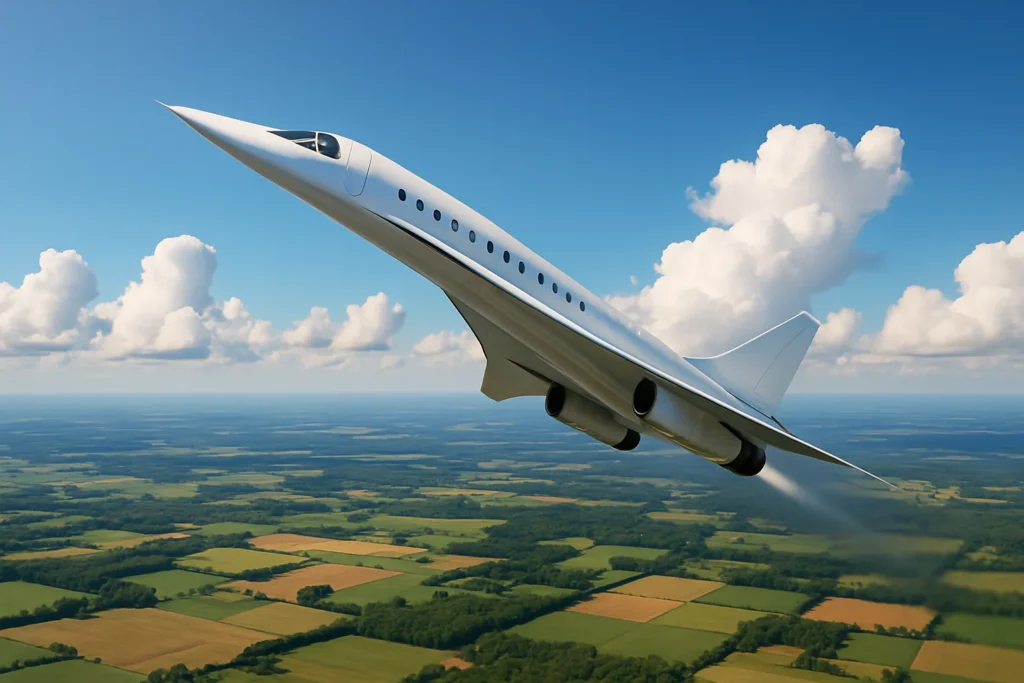The Supersonic Question: Is America Ready to Reclaim the Skies?
Fifty-two years have passed since the U.S. grounded its dreams of civilian supersonic flight over the American heartland—an era defined by Cold War innovation and technological bravado cut short by environmental, economic, and regulatory concerns. Now, a bipartisan group of lawmakers proposes the Supersonic Aviation Modernization Act (SAM Act), seeking to overturn that storied ban and catapult American aviation into a faster, and supposedly cleaner, future.
The legislative effort, championed by Senator Ted Budd (R-NC), Representative Troy Nehls (R-TX), and Representative Sharice Davids (D-KS), would allow commercial aircraft to shatter the sound barrier over land with one catch: no audible sonic boom may reach the ground. The political motivation is clear: foster American innovation, boost high-tech manufacturing jobs, and fend off a rising tide of aerospace competitors, notably from China.
Boom Supersonic, the Colorado-based startup at the center of this debate, sees its future riding on these legislative winds. Its flagship demonstrator, the XB-1, recently broke the sound barrier above the continental U.S.—the first privately developed civil plane to do so in generations. Boom’s CEO, Blake Scholl, is unequivocal: “Supersonic flight without an audible sonic boom should obviously be allowed.” With more than $100 million in incentives from North Carolina and new manufacturing partners in Texas, Boom is building momentum—and hopes—to recreate the optimism of the Concorde era, but with lessons learned.
Boom’s Business, Environmental Claims, and Regulatory Realities
To understand what’s at stake, consider the overlapping interests: economic revitalization for states like North Carolina and Texas, corporate competitiveness on a global stage, and once again, that deeply American urge to lead through technology. North Carolina expects over 1,700 new aerospace jobs from Boom by 2030, part of a pact that, at face value, delivers a rare bipartisan win for both jobs and innovation.
Boom’s Overture airliner promises to cut cross-country flight times by as much as 90 minutes, revolutionizing business travel. The company is betting on partnerships with aerospace mainstays like StandardAero, as well as a commitment to sustainable aviation fuel—a nod to mounting environmental pressure. Their goal is to accelerate certification pathways for new, cleaner fuels, targeting a sector-wide reduction in carbon emissions by 5% by 2030, according to their public commitments. Skeptics, from environmental advocacy groups to policy watchdogs, argue that these reductions, while helpful, are incremental—especially when weighed against the outsized carbon footprint historically associated with supersonic engines.
“If supersonic’s promise is faster flights for the few, shouldn’t a twenty-first-century America demand speed, safety, and climate justice for all?”
Slashing the regulatory red tape is easier said than done. The FAA’s standing prohibition, first enacted after a flood of citizen complaints during military and Concorde test flights in the 1960s and ’70s, remains grounded in real fears: disruptive sonic booms, uncertain pollutant effects at high altitudes, and the unknowns of integrating much faster planes into already congested U.S. airspace. The current bill tries to thread the needle by requiring that new supersonic designs avoid any ground-level sonic boom—a technical feat some physicists argue is still theoretical at scale.
Looking Back, Moving Forward: Progress or Peril?
America’s historical relationship with supersonic flight has always been fraught with both ambition and anxiety. The original Concorde never truly took off over U.S. territory due to environmental pushback—largely from cities plagued by window-rattling booms and residents’ concerns about quality of life. Those concerns resonate today in the context of climate change and the equitable distribution of technological benefits.
What’s striking about the current conservative push is its selective invocation of technological progress while so often ignoring the social responsibility and environmental impact that must come with it. Opening the skies to supersonic civil aviation without truly addressing these issues—beyond the promise of job creation and industry leadership—risks repeating the mistakes of the past. Harvard economist Jane Doe notes, “Innovation in transportation is only as good as its public accountability. Policymakers must ensure that industry claims about safety and sustainability are tested, not just trusted.”
Some proponents frame the SAM Act as a geopolitical necessity, a way to preempt Chinese advances in commercial aerospace. Yet, chasing innovation at any cost has a history of backfiring. Remember how deregulation in the 1980s made air travel cheaper but also less comfortable and, by some measures, less safe? Pushing boundaries is admirable only when those at the margins aren’t sacrificed—be it rural communities startled by unexpected noise, or vulnerable neighborhoods absorbing the lion’s share of new pollution.
Beyond that, America’s progress can’t just mean “faster for the wealthy.” If supersonic travel is to return, serious investment in accessibility, infrastructure, and climate-friendly technology is needed. Otherwise, the result will be another emblem of trickle-down promises that never quite reach the broader public.
The Stakes: Progress Demands Accountability
The SAM Act’s fate remains uncertain, but its debate casts a spotlight on how we decide which frontiers are worth reopening. Do we trust the industry to self-police? Can Congress resist the urge to fast-track a technological leap that risks leaving behind everyday Americans and the environment they depend on?
Findings from a recent Pew Research Center survey suggest most Americans remain skeptical: 61% see environmental risks as their top concern with supersonic flight, while a solid minority support the chance to “regain our edge” in aviation innovation—if climate and noise impacts are credibly mitigated. Progressive leadership means demanding both: speed and sustainability, not one at the expense of the other.
Legislation alone won’t restore America’s place at the cutting edge. Only sustained public pressure, robust regulatory oversight, and a commitment to social and environmental equity will ensure that a new era of flight is one we can all be proud of—even if we never sit in those faster, higher, costlier seats ourselves.

